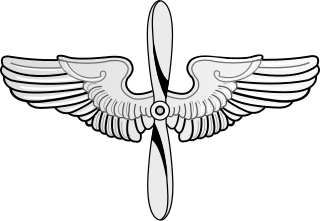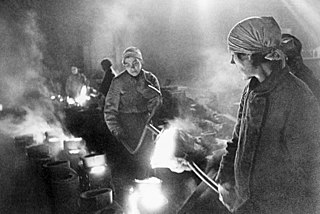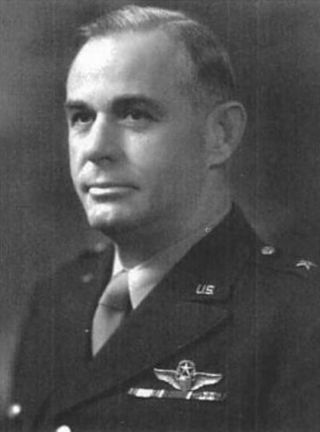
The Douglas Aircraft Company was an American aerospace and defense company based in Southern California. Founded in 1921 by Donald Wills Douglas Sr., it merged with McDonnell Aircraft in 1967 to form McDonnell Douglas, where it operated as a division. McDonnell Douglas merged with Boeing in 1997.

North American Aviation (NAA) was a major American aerospace manufacturer that designed and built several notable aircraft and spacecraft. Its products included the T-6 Texan trainer, the P-51 Mustang fighter, the B-25 Mitchell bomber, the F-86 Sabre jet fighter, the X-15 rocket plane, the XB-70, the B-1 Lancer, the Apollo command and service module, the second stage of the Saturn V rocket, and the Space Shuttle orbiter.

The Republic Aviation Corporation was an American aircraft manufacturer based in Farmingdale, New York, on Long Island. Originally known as the Seversky Aircraft Company, the company was responsible for the design and production of many important military aircraft, including its most famous products: World War II's P-47 Thunderbolt fighter, the F-84 Thunderjet and F-105 Thunderchief jet fighters, as well as the A-10 Thunderbolt II close-support aircraft.

The Douglas A-20 Havoc is an American medium bomber, attack aircraft, night intruder, night fighter, and reconnaissance aircraft of World War II.

The United States Army Air Service (USAAS) was the aerial warfare service component of the United States Army between 1918 and 1926 and a forerunner of the United States Air Force. It was established as an independent but temporary branch of the U.S. War Department during World War I by two executive orders of President Woodrow Wilson: on May 24, 1918, replacing the Aviation Section, Signal Corps as the nation's air force; and March 19, 1919, establishing a military Director of Air Service to control all aviation activities. Its life was extended for another year in July 1919, during which time Congress passed the legislation necessary to make it a permanent establishment. The National Defense Act of 1920 assigned the Air Service the status of "combatant arm of the line" of the United States Army with a major general in command.

Military production during World War II was the production or mobilization of arms, ammunition, personnel and financing by the belligerents of the war, from the occupation of Austria in early 1938 to the surrender and occupation of Japan in late 1945.

William Signius Knudsen was a leading Danish-American automotive industry executive and an American general during World War II. His experience and success as a key senior manager in the operations sides of Ford Motor Company and then General Motors led the Franklin Roosevelt administration to commission him directly as a lieutenant general in the United States Army to help lead the United States' war materiel production efforts for World War II.

Air Transport Command (ATC) was a United States Air Force unit that was created during World War II as the strategic airlift component of the United States Army Air Forces.

The Liberty L-12 is an American water-cooled 45° V-12 aircraft engine displacing 1,649 cubic inches (27 L) and making 400 hp (300 kW) designed for a high power-to-weight ratio and ease of mass production. It saw wide use in aero applications, and, once marinized, in marine use both in racing and runabout boats.

Military gliders have been used by the militaries of various countries for carrying troops and heavy equipment to a combat zone, mainly during the Second World War. These engineless aircraft were towed into the air and most of the way to their target by military transport planes, e.g., C-47 Skytrain or Dakota, or bombers relegated to secondary activities, e.g., Short Stirling. Most military gliders do not soar, although there were attempts to build military sailplanes as well, such as the DFS 228.

The Willys MB and the Ford GPW, both formally called the U.S. Army Truck, 1⁄4‑ton, 4×4, Command Reconnaissance, commonly known as the Willys Jeep, Jeep, or jeep, and sometimes referred to by its Standard Army vehicle supply nr. G-503, were highly successful American off-road capable, light military utility vehicles. Well over 600,000 were built to a single standardized design, for the United States and the Allied forces in World War II, from 1941 until 1945. This also made it the world's first mass-produced four-wheel-drive car, built in six-figure numbers.

"Arsenal of Democracy" was the central phrase used by U.S. President Franklin D. Roosevelt in a radio broadcast on the threat to national security, delivered on December 29, 1940—nearly a year before the United States entered the Second World War (1939–1945). Roosevelt promised to help the United Kingdom fight Nazi Germany by selling them military supplies while the United States stayed out of the actual fighting. The president announced that intent a year before the Attack on Pearl Harbor, at a time when Germany had occupied much of Europe and threatened Britain.

Howard Aircraft Corporation was a small United States aircraft manufacturer in the 1930s and 1940s. The factory was initially on the south side of Chicago Municipal Airport at 5301 W. 65th Street; during World War II a second plant was opened at DuPage Airport west of Chicago.

The Fleetwings BT-12 Sophomore, also known by the company designation Model 23, was a 1940s all-metal basic training monoplane built by Fleetwings for the United States Army Air Forces. Only 24 production examples of the type were built before the contract was cancelled.

Interstate Aircraft and Engineering Corporation was a small American aircraft manufacturer in production from April 1937 to 1945, based in El Segundo, California.

Oliver Patton Echols was an American military officer who brought success in World War II to the United States Army Air Forces by expanding the inventory of America's air arm to meet the needs of the coming war. More than any other man under Chief of the Army Air Forces, General Henry H. Arnold, Echols was responsible for the development, procurement and supply of aircraft and aeronautical equipment. Fighter projects officer Benjamin S. Kelsey, directly subordinate to Echols from 1934 to 1945, called him "The Man Who Won World War II."

The United States Army Air Forces was the major land-based aerial warfare service component of the United States Army and de facto aerial warfare service branch of the United States during and immediately after World War II (1941–1947). It was created on 20 June 1941 as successor to the previous United States Army Air Corps and is the direct predecessor of the United States Air Force, today one of the six armed forces of the United States. The AAF was a component of the United States Army, which on 2 March 1942 was divided functionally by executive order into three autonomous forces: the Army Ground Forces, the United States Army Services of Supply, and the Army Air Forces. Each of these forces had a commanding general who reported directly to the Army Chief of Staff.

The United States Army Air Corps (USAAC) was the aerial warfare service component of the United States Army between 1926 and 1941. After World War I, as early aviation became an increasingly important part of modern warfare, a philosophical rift developed between more traditional ground-based army personnel and those who felt that aircraft were being underutilized and that air operations were being stifled for political reasons unrelated to their effectiveness. The USAAC was renamed from the earlier United States Army Air Service on 2 July 1926, and was part of the larger United States Army. The Air Corps became the United States Army Air Forces (USAAF) on 20 June 1941, giving it greater autonomy from the Army's middle-level command structure. During World War II, although not an administrative echelon, the Air Corps (AC) remained as one of the combat arms of the Army until 1947, when it was legally abolished by legislation establishing the Department of the Air Force.

Air warfare was a major component in all theaters of World War II and, together with anti-aircraft warfare, consumed a large fraction of the industrial output of the major powers. Germany and Japan depended on air forces that were closely integrated with land and naval forces; the Axis powers downplayed the advantage of fleets of strategic bombers and were late in appreciating the need to defend against Allied strategic bombing. By contrast, Britain and the United States took an approach that greatly emphasized strategic bombing and tactical control of the battlefield by air as well as adequate air defenses. Both Britain and the U.S. built substantially larger strategic forces of large, long-range bombers. Simultaneously, they built tactical air forces that could win air superiority over the battlefields, thereby giving vital assistance to ground troops. The U.S. Navy and Royal Navy also built a powerful naval-air component based on aircraft carriers, as did the Imperial Japanese Navy; these played the central role in the war at sea.

The North American NA-40 was an American prototype bomber aircraft developed by North American Aviation in the late 1930s for evaluation by the United States Army Air Corps. Although unsuccessful, it led directly to the North American B-25 Mitchell medium bomber.




















